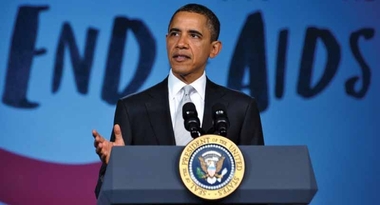Everyone is needed to end the HIV epidemic

This year, when President Obama observed the 35th anniversary of HIV/AIDS in the United States, he said, “We've learned that stigma and silence don't just fuel ignorance, they foster transmission and give life to a plague. We've seen that testing, treatment, education, and acceptance can not only save and extend lives, but fight the discrimination that halted progress for too long.”
The Obama administration has worked hard on both fighting HIV/AIDS and LGBTQ discrimination both at home and abroad. The President has embraced the goal of an AIDS-free generation, joining the global community in committing to ending the epidemic by 2030.
One of the President’s top HIV/AIDS policy priorities is the development and implementation of a National HIV/AIDS Strategy (NHAS). There are three primary goals for the NHAS:
Reducing HIV incidence
Increasing access to care and optimizing health outcomes
Reducing HIV-related health disparities
The Administration has maintained a commitment to developing the NHAS through a process that is inclusive of a broad range of perspectives and stakeholders, and the Office of National AIDS Policy (ONAP) has engaged public involvement via multiple channels.
ONAP began engaging the community in developing the national strategy by holding community meetings in 14 cities, with more than 4,200 people attending the community discussions. From those meetings, and additional online discussions, ONAP developed a report introducing themes to achieve the goals listed above.
Perhaps the most stressed theme was to create a national campaign to increase public awareness and prevention of HIV, with a particular focus on youth. Another was to routinize, increase and improve testing.
The facts driving the need for action are sobering:
Approximately one in five people living with HIV are unaware that they have HIV, placing them at greater risk for spreading the virus to others.
Gay and bisexual men and racial/ethnic minorities comprise the greatest proportion of HIV cases in the United States.
HIV-positive racial and ethnic minorities are more likely to be diagnosed later in their infection and die sooner than whites.
One quarter of Americans living with HIV are women, and the disease is disproportionately impacting women of color. HIV/AIDS is one of the leading causes of death among Black women and Latinas.
Twenty-nine percent of HIV diagnoses occur among adolescents and young adults (ages 13 to 29).
Twenty-four percent of people living with HIV are 50 or older, and 15 percent of new HIV/AIDS cases occur among people in this age group.
ONAP worked to develop plans to advance the strategy, and it was updated with actions outlined through 2020. Among the steps proposed:
Intensify HIV prevention efforts in the communities where HIV is concentrated, and educate all Americans with easily accessible, scientifically accurate information about HIV risks, prevention, and transmission.
Establish seamless systems to link people to care immediately after diagnosis. Unfortunately, there continues to be a high percentage of people who know they have HIV, but are not getting treatment for it.
Reduce HIV-related disparities in communities at high risk for HIV infection
The implementation of the Affordable Care Act has increased access to health insurance and healthcare, but the number of providers and the cost of the policies are still major roadblocks to getting affordable care. However, it does allow access to cost-free testing.
It is a big step from understanding the problems involved to successful action on prevention, treatment, vaccines and cures for HIV. When the update was issued in 2015, the Executive Summary concluded with this observation: “Key focus areas for the Update include HIV testing with linkage to care for those with HIV infection, along with support for retention in care and treatment adherence to ensure that persons living with HIV remain virally suppressed, and for those testing negative but at substantial risk, linkage to PrEP and support for medication adherence. This Update is a call to action to myriad systems: everyone is needed to put this Strategy into action and end the HIV epidemic.”
Copyright 2016 The Gayly – December 5, 2016 @ 7:45 a.m.





